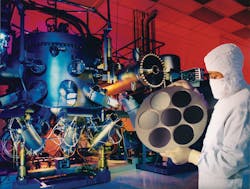This file type includes high resolution graphics and schematics when applicable.
Active devices for many roads will literally depend on millimeter-wave signals for automotive safety. And if Fifth-Generation (5G) cellular wireless-communications networks use millimeter-wave backhaul links for high-data-rate signal transfers, high-frequency circuit designers will see an unprecedented demand for semiconductors capable of sending and receiving signals at 60 to 80 GHz and beyond.
Fortunately, at least one semiconductor foundry is already established as a logical starting place for the design and development of millimeter-wave discrete devices and integrated circuits (ICs)—Northrop Grumman’s Microelectronic Products & Services’ foundry in Redondo Beach, Calif. While the prime contractor is associated with defense systems, the foundry is available to commercial and military customers through MPS. It offers the equipment and the expertise necessary to produce devices and circuits at frequencies as high as 340 GHz.
The Northrop Grumman facility (Fig. 1) is a U.S. Department of Defense (DoD) trusted foundry, one that is well-equipped to fabricate a number of different high-frequency semiconductor technologies. These include devices and circuits on gallium-arsenide (GaAs), gallium-nitride (GaN), and indium-phosphide (InP) wafers. Three different processes are available on GaAs, based on pseudomorphic high-electron-mobility-transistor (pHEMT) active devices. One process is able to fabricate device gates with 0.15-µm gate lengths with maximum frequency for unity current gain (ft) of 80 GHz and maximum frequency of oscillation (fmax) of 200 GHz.
The other processes (low noise and power) provide 0.10-µm gate features with ft of 120 GHz and fmax of 250 GHz. The GaN HEMT process is capable of producing high-power devices with minimum feature size of 0.20 µm and maximum collector-emitter and drain-source voltage of 28 V.
The GaN HEMTs feature ft of 60 GHz and fmax of 200 GHz. As noted in scores of articles, GaN HEMTs have become the active device of choice for high-power RF/microwave monolithic microwave integrated circuits (MMICs), notably for amplifiers and switches. The semiconductor material has the high electron velocity needed for high-speed, high-frequency circuits—but also much higher power density and breakdown voltage than other high-frequency materials, such as GaAs, for building high-power amplifiers that are small in size.
The GaN HEMT process technology provides two metal-interconnection layers, thin-film resistors, metal-insulator-metal (MIM) capacitors, air bridges, and backside vias for constructing high-power, high-frequency components and circuits. Amplifiers fabricated with the 0.2-µm GaN HEMT process have served such applications as military radar systems and satellite-communications (satcom) systems.
The diversified foundry offers four different InP processes: three based on heterojunction bipolar transistors (HBTs) and the fourth on pHEMTs. A 1-µm InP HBT process developed nominally for higher-power devices at high frequency has ft of 80 GHz and fmax of 150 GHz. The other two InP HBT processes are nominally geared for high-speed digital circuits, such as analog-to-digital converters (ADCs) and digital-to-analog converters (DACs), with minimum feature sizes of 0.8 and 0.6 µm. The former has ft of 160 GHz and fmax of 200 GHz, while the latter has ft of 250 GHz and fmax of 300 GHz. The fourth InP process at Northrop Grumman’s foundry, based on pHEMT active devices, realizes minimum feature size of 0.1 µm and achieves ft of 180 GHz and fmax of 350 GHz.
The high performance of the processes is achieved with the aid of molecular-beam epitaxy (MBE) for deposition of single-crystal thin films on each wafer under high-vacuum conditions (Fig. 2). Multiple-wafer MBE reactors enable the fabrication of high-purity device structures for excellent performance at millimeter-wave frequencies, while also achieving respectable device yields per wafer. All processes begin with 100-mm-diameter wafers of a material of choice, with thicknesses between 50 and 100 µm, depending on material.
The foundry staff works closely with customers to meet the most challenging requirements, providing process design kits (PDKs) optimized for specific application areas, including power, low-noise, and millimeter-wave applications. The PDKs are compatible with most commercial simulation software tools, including those from Cadence Design Systems, Keysight Technologies, and National Instruments/AWR. In addition, the foundry has on-wafer test capabilities that extend beyond 110 GHz for evaluating performance levels through millimeter-wave frequencies before it is time for packaging.
Northrop Grumman Corp., Microelectronic Products & Services (MPS), One Space Park, Redondo Beach, CA 90278; (310) 814-5000
This file type includes high resolution graphics and schematics when applicable.




